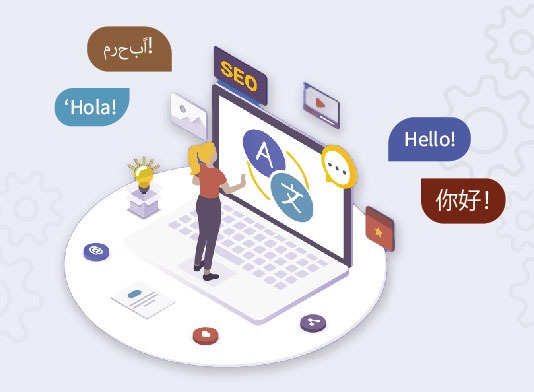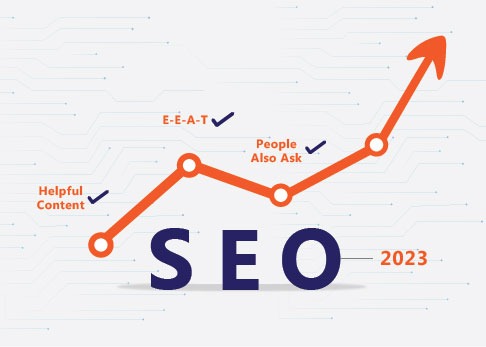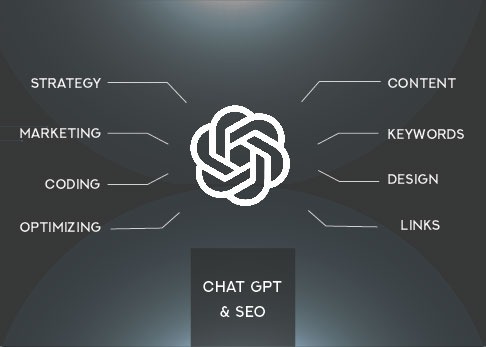SEO for multi-language websites: How to speak your customers’ language
SEO for multi-language websites is a complex and often overlooked aspect of website design and development. When optimizing for multiple languages, it is important to consider both the technical and cultural aspects involved. The technical aspects involve optimizing the website for multiple languages, while the cultural aspects involve understanding and speaking the language of the target market. The first step to optimizing for multiple languages is to ensure that the website is properly coded. This includes using the correct language codes, properly setting the language preferences for each page, and using the correct character encoding. All of these elements must be properly set in order for the website to be properly indexed by search engines. Once the technical aspects are taken care of, the next step is to create content that is tailored to the target market. This can be done by creating content that is written in the native language of the target market.

This content should include keywords and phrases that are relevant to the target market, as well as topics that are of interest to them. It is also important to ensure that all content is written in a way that is easy to understand, even if the reader is unfamiliar with the language. The final step to optimizing for multiple languages is to ensure that the website is properly linked to other websites and social media accounts in the target language. This includes setting up accounts on social media networks in the target language and using links from these accounts to direct users to the website. Additionally, links from other authoritative websites in the target language should be included to help improve the website’s visibility. By taking these steps, businesses can ensure that their website is properly optimized for multiple languages. This will help to increase visibility and website traffic, as well as improve the overall user experience for customers in the target language. Additionally, it will help to build trust and relationships with customers in the target language, which can lead to increased sales and more returning customers.
SEO opportunities in 2023: Helpful content, E-E-A-T, People also ask
SEO opportunities in 2023 will require marketers to focus on creating helpful content and using the latest trends and best practices to ensure their content is seen and ranked by search engine algorithms. The first way to improve SEO in 2023 is to focus on creating helpful content. Content that provides useful information to users while being easy to read and digest is essential for SEO success. Content should be written in a way that is conversational and easy to understand, while still providing valuable insights. Additionally, content should be optimized for search engine algorithms by using keywords and phrases related to the topic. Content should also be optimized for mobile devices, as more searches are being performed on mobile devices than ever before. The second way to improve SEO in 2023 is to focus on E-E-A-T, which stands for Expertise, Authoritativeness, and Trustworthiness. This means that content should come from experts in the field, be authoritative and trustworthy, and be written in an easy-to-understand way. Additionally, content should be well-researched and include statistics and data to support claims made.

The third way to improve SEO in 2023 is to use the latest trends and best practices. This includes optimizing content for voice search, utilizing local SEO tactics to increase visibility in localized searches, and utilizing structured data to ensure content is seen by search engine algorithms. Additionally, marketers should be aware of the “People also ask” feature, which allows users to ask questions related to a specific topic and receive answers from an authoritative source. Finally, marketers should focus on creating longer-form content that provides more in-depth information than shorter content. Content should be at least 400 words in length, with more detailed content providing more value to users. Content should also be broken up into bite-sized chunks with headings, subheadings, and bulleted lists to make the content easier to read and digest. Additionally, content should include visuals, such as images, videos, and infographics, as visuals are more likely to engage users and keep them on the page longer. By following these guidelines and using the latest trends and best practices, marketers can create content that is optimized for search engine algorithms and provides users with valuable information. This will ensure that content is seen and ranked by search engine algorithms, leading to increased visibility, traffic, and conversions in 2023.
ChatGPT is Secret Weapon for SEO Content Editing
ChatGPT is an AI-powered tool that helps content marketers create SEO-optimized content easily and quickly. It uses natural language processing (NLP) to understand the content the user is creating and suggest the most relevant keywords, phrases, and topics to use in the content. The tool helps content marketers to optimize their content for search engine rankings, as well as to create content that is engaging and relevant to the target audience. ChatGPT works by analyzing the content that the user is producing and suggesting the most relevant keywords and phrases to use. It also suggests topics and phrases that are related to the content being created, increasing the relevance of the content to the audience. This helps the content to rank higher in search engine results. ChatGPT also helps to create content quickly.

It provides users with a list of suggested keywords and phrases that can be used in the content. This helps to save time and effort as it eliminates the need to manually research keywords and phrases. The tool also suggests topics and phrases that are related to the content, making it easier for the user to create content that is optimized for SEO. In addition to optimizing SEO content, ChatGPT is also an invaluable tool for content writers. It can help users to quickly create content that is engaging, relevant, and SEO-friendly. With its help, users can create content that will attract more readers and increase the chances of ranking higher in search engine results. ChatGPT is an easy to use tool that helps content marketers create SEO-optimized content quickly and easily. Its use of natural language processing, keyword and topic suggestions, and content optimization make it an invaluable tool for content writers looking to create content that is engaging, relevant, and SEO-friendly.
Non-stop Updates: SEOs Share the Impact on their Day-to-Day, Work-Life Balance and Career Outlook
Search Engine Optimization (SEO) has become an increasingly important part of digital marketing and web development. To stay competitive, SEO professionals must keep up with the ever-changing landscape of search engine algorithms, as well as new tools, technologies, and strategies for optimizing websites for better rankings. As such, SEO professionals must be able to adapt quickly and adjust their strategies accordingly to remain ahead of the competition.
The importance of constant SEO updates can have a major impact on the day-to-day work-life balance of SEO professionals. It can be difficult to keep up with the rapid pace of SEO updates, as there is always something new to learn and apply. SEO professionals must be able to juggle multiple tasks at once, such as keyword research, content optimization, and link building.

This type of multitasking can be difficult to manage, especially when the updates come in at a rapid pace. The constant updates can also impact the career outlook of SEO professionals. As the search engine algorithms and best practices continue to evolve, SEO professionals must remain up-to-date on the latest trends and strategies. Without staying current, SEO professionals risk falling behind their competitors and losing out on lucrative opportunities. Additionally, the ever-changing landscape of SEO can make it difficult to stay ahead of the competition and stay ahead in the field.
The impact of non-stop updates on SEO professionals’ day-to-day work-life balance and career outlook is clear. SEO professionals must be willing to invest the time and energy into staying up-to-date on the latest trends and techniques. They must also be able to juggle multiple tasks and stay flexible in their approach to SEO. For those who are willing to put in the work, the rewards can be great. By staying ahead of the competition and taking advantage of new opportunities, SEO professionals can position themselves for long-term success.
Web Hosting for SEO: Why it’s Important
Search engine optimization (SEO) is an essential part of any website’s success. SEO helps increase website visibility, traffic, and conversions. When it comes to SEO, hosting plays an important role. A reliable web hosting service can have a significant impact on your SEO efforts.
Web hosting speed is a major factor in SEO. The faster your website loads, the better your chances of ranking higher in search engine results. Google has even explicitly stated that page speed is a ranking factor in its search algorithm. A slow website can lead to lower rankings, fewer visitors, and decreased conversions. Web hosting uptime is also important in SEO. If your website is down, your customers won’t be able to access it. Google doesn’t like websites that are unavailable, and it can penalize you if your website is down for extended periods of time. A reliable web hosting service can help ensure that your website is always running, so you don’t have to worry about downtime affecting your rankings.

Security is another important factor. If your website is vulnerable to cyberattacks, your rankings can suffer. If a hacker gains access to your website, they can inject malicious code that can damage your website and lead to a loss of rankings. A reliable web hosting service can help protect your website from these attacks. Finally, web hosting can also have an impact on your website’s overall performance. If your website is hosted on a slow server, it can cause your website to load slowly and affect your rankings. A reliable web hosting service can help ensure that your website loads quickly and efficiently. In conclusion, web hosting is an important factor in SEO. A reliable web hosting service can help ensure that your website loads quickly, is always available, and is secure. This can all have a positive impact on your website’s rankings and performance.
SEO Product Management: Key Framework and Fundamentals
SEO product management involves the development, optimization and management of products to increase the visibility of a website in search engine results. It includes key fundamentals such as keyword research, content optimization, link building, analytics tracking and reporting.
Keyword research: Keyword research is the foundation of any SEO product management strategy. It involves researching and analyzing relevant keywords related to the product or service being offered. The goal is to find keywords that have high search volume and low competition. This helps ensure that when someone searches for that keyword, the website is more likely to appear near the top of the search engine results page (SERP).
Content optimization: Once the keywords are identified, the next step is to optimize the content on the website and ensure it is optimized for those keywords. This includes writing or editing the page copy, optimizing images, adding meta tags and ensuring the content is structured in a way that search engine crawlers can easily understand.

Link building: Link building is an important part of SEO product management. It involves creating backlinks to the website from other websites, which can help increase the website’s visibility in search engine results. Analytics tracking and reporting: Analytics tracking and reporting is also an important part of SEO product management. It involves using tools such as Google Analytics to track and analyze the website’s performance in search engine results, as well as other metrics such as user engagement and conversions. This helps identify areas of improvement and determine the effectiveness of the SEO strategy.
These are the key fundamentals of SEO product management. By implementing these fundamentals, businesses can ensure that their website is visible to their target audience and more likely to appear near the top of the SERP.
How SEO Professionals & Agencies Win New Business
SEO professionals and agencies win new business by demonstrating their expertise in search engine optimization (SEO). They must be able to demonstrate their knowledge of SEO principles, show the success they’ve achieved for past clients, and explain how their approach differs from others in the industry.
When it comes to SEO, the primary goal is to increase the visibility of a website in search engine results. SEO professionals must understand how search engine algorithms work, how to optimize content, and how to build links that will improve a website’s ranking. They must also understand how to implement strategies such as keyword research, link building, and on-page optimization.
In order to win new business, SEO professionals and agencies must be able to demonstrate their knowledge of SEO and showcase the success they’ve achieved for past clients. They can do this by providing case studies, white papers, and other evidence of their success. They can also provide testimonials from past clients, or offer a free SEO audit to potential clients. This will help to build trust in their abilities and show the potential client that the agency is knowledgeable and experienced in the field.

In addition to showcasing their knowledge and experience, SEO professionals and agencies must also be able to explain their approach to search engine optimization. They must be able to explain the strategies they plan to use to improve a website’s ranking, as well as the timeline they anticipate for achieving results. It’s important that they can explain how their approach is different from other SEO professionals and agencies, and why they believe their approach is the best option for the client.
Finally, SEO professionals and agencies must be able to develop and present a comprehensive proposal that outlines the cost of their services and the timeline for achieving results. This proposal should also include a detailed plan of action and the measures the agency will take to track and measure results.
Microsoft list of Bingbot IP addresses released
Bingbot is a web crawling robot created by Microsoft. It is used to index webpages for the Bing search engine. The Microsoft list of Bingbot IP addresses is a list of IP addresses that are used by Bingbot to crawl websites. This list is released by Microsoft to allow webmasters to control access to their websites.
The list of Bingbot IP addresses is updated periodically and contains both IPv4 and IPv6 addresses. The list can be found on the Microsoft website and can be used to configure access control rules on web servers. This allows webmasters to whitelist or blacklist IP addresses to control which requests are allowed or blocked. This can help protect websites from malicious actors, as well as limit access by legitimate crawlers such as Bingbot.
The list of Bingbot IP addresses is organized by geographic region. This allows webmasters to control access to their websites based on location. For example, if a website owner wants to block requests from certain countries, they can use the list to create access control rules that limit requests from the specified countries.

{
“creationTime”: “2021-11-10T10:00:00.121331”,
“prefixes”: [
{
“ipv4Prefix”: “157.55.39.0/24”
},
{
“ipv4Prefix”: “207.46.13.0/24”
},
{
“ipv4Prefix”: “40.77.167.0/24”
},
{
“ipv4Prefix”: “13.66.139.0/24”
},
{
“ipv4Prefix”: “13.66.144.0/24”
},
{
“ipv4Prefix”: “52.167.144.0/24”
},
{
“ipv4Prefix”: “13.67.10.16/28”
},
{
“ipv4Prefix”: “13.69.66.240/28”
},
{
“ipv4Prefix”: “13.71.172.224/28”
},
{
“ipv4Prefix”: “139.217.52.0/28”
},
{
“ipv4Prefix”: “191.233.204.224/28”
},
{
“ipv4Prefix”: “20.36.108.32/28”
},
{
“ipv4Prefix”: “20.43.120.16/28”
},
{
“ipv4Prefix”: “40.79.131.208/28”
},
{
“ipv4Prefix”: “40.79.186.176/28”
},
{
“ipv4Prefix”: “52.231.148.0/28”
},
{
“ipv4Prefix”: “20.79.107.240/28”
},
{
“ipv4Prefix”: “51.105.67.0/28”
},
{
“ipv4Prefix”: “20.125.163.80/28”
},
{
“ipv4Prefix”: “40.77.188.0/22”
},
{
“ipv4Prefix”: “65.55.210.0/24”
},
{
“ipv4Prefix”: “199.30.24.0/23”
},
{
“ipv4Prefix”: “40.77.202.0/24”
},
{
“ipv4Prefix”: “40.77.139.0/25”
},
{
“ipv4Prefix”: “20.74.197.0/28”
}
]
}
The Microsoft list of Bingbot IP addresses also includes other information. This includes the date when the list was last updated and the version of the list. This allows webmasters to keep their access control rules up to date.Using the list of Bingbot IP addresses is an effective way to control access to websites. It can help protect websites from malicious actors, as well as limit access by legitimate crawlers such as Bingbot. This can help webmasters ensure that their websites are properly indexed by search engines such as Bing.
SEO community feels blindsided by November core update as Google defends timing
The SEO community has been blindsided by the November 2020 Core Update from Google. This update, which began rolling out on November 10th, was announced just a few days before, leaving SEOs and webmasters with little time to prepare for the changes. The update is the second major core update of 2020 and follows the May 2020 Core Update. It’s unclear what specific changes have been made, but the update is expected to have far-reaching implications for websites. SEOs are concerned that the update could have a significant impact on organic rankings, especially as some websites have seen drastic changes in their rankings overnight. The timing of the update has been particularly frustrating for SEOs, as they were given no warning or time to prepare.

Google typically announces core updates a few weeks in advance, giving webmasters time to adjust their strategies and make any necessary changes. This update, however, was announced just a few days before, leaving SEOs scrambling to make sense of the changes. Google has defended its timing, saying that it was necessary to ensure the update was rolled out smoothly. Google also noted that this is not an unusual practice and that core updates are often announced and deployed at the same time. Despite Google’s defense of its timing, the SEO community still feels blindsided by the update. With so little warning, many SEOs feel that they were unprepared for the changes and may have lost valuable time that could have been spent making adjustments.
The November 2020 Core Update is the latest in a series of changes from Google that have left many SEOs feeling frustrated and confused. Although Google has defended its timing and noted that core updates are often announced and deployed at the same time, the SEO community is still feeling blindsided by the sudden announcement and rollout of this update. With so little warning, many webmasters were unable to prepare for the changes and may have lost valuable time that could have been spent making adjustments.
Top SEO predictions 2020
With more and more new web pages are popping up every day, the online world is much more competitive than ever before. So, if you are a business owner looking for ways to get ahead in online competition, you need to tackle search engine optimization in a new innovative way. Read on the article to know more about the top SEO predictions for 2020.

Authority matters – One of the huge ranking factors is domain authority and it continues to be same in 2020 too. The only thing changed is, how you earn it. In order to build the website’s authority, links are much more used and gathering backlinks is the name of the game. If you are getting more backlinks, your domain authority will be high. Also, to dominate search engine results page rankings, create incredibly great content for your website and build up your brand effectively. Once you focus more on creative and reliable content within your business, you can excellently demonstrate your authoritativeness and reliability. Try to clean up your page by removing poor content, broken links and some other technical faults if present. This is what big sites often do and this is how they earn higher rankings in major SERPs. Always be transparent about who you are and what you are doing exactly. Then, build your credibility by getting quality backlinks from numerous higher ranking pages eventually build your domain authority.
Voice search is going to be a big hit – This concept is nothing new, but the advancements in Google voice search certainly would add more excitement to your search and give you a happy browsing experience. The changing search trends have shown that Google voice search is a real thing finally. It is said that every single adult performs a voice search once or twice in a day. Actually the adoption rate of this feature is quite slower than predicted, but it has impacted our search options and it is predicted to be a huge hit in 2020.
Content is always king – Experts have been saying that content is the ultimate king for a long time now. If you place quality content on your website, you can attract more visitors and drive in more traffic to your website eventually. If you give your clients what exactly they want through quality content, they will offer you with higher sales and better profits. Always create value adding content and place it on your webpage to entice more visitors. Content was the king, is the king and will always be the king.
Fake reviews will be flagged as inappropriate – Prospective customers tend to read the review fist before going for a purchase. Many business owners are writing fake reviews to build their credibility. Since these reviews hold the power to elevate and destroy the business, major search engines are striving hard to prevent businesses from unreliable people and still looking for better ways to get rid of fake reviews.
Responsive pages will be rewarded more – With the availability of many free and cheap page builders, lots and lots of websites are being made every day. This is actually a challenging thing to Google, since it has to effectively process, assess and rank these sites. But these things apart, only unique pages will be indexed by Google. If the site has responsive pages with lean code and organized content, it will be rewarded high by Google. Having a strong online presence will earn you more visitors and keep your customers coming back to your over and time again. It also helps build credibility and constructive brand recognition.
Irrespective of the many changes made in search engine algorithms, factors like quality content, optimized content, device responsiveness and structured page remain indispensable elements in online success. Most importantly, try to make your website in compliance with Google guidelines and white hat strategies to earn lucrative long term results. As an SEO expert, you need to think outside the box and apply more effective ways to your SEO strategy 2020 and be at high point all the time. Since SEO is an intricate field, you need to stay abreast of the most recent developments in order to make certain that you are on the right track to achieve finest results. In the year 2020, Google is focusing more on websites that are filled up with quality and reliable content. So, change your SEO strategy in 2020, create rich feature snippets and you will be all set for success. In order to make your business thrive online, it is extremely important to partner with an SEO agency that helps you in your internet marketing campaign. A right SEO company will contribute more to your bottom line and help improve your online presence.
Blogroll
Categories
- 2013 seo trends
- author rank
- Bing search engine
- blogger
- Fake popularity
- Google Adsense
- google fault
- google impact
- google Investigation
- google knowledge
- Google panda
- Google penguin
- Google Plus
- Google webmaster tools
- Hummingbird algorithm
- infographics
- link building
- Mattcutts Video Transcript
- Microsoft
- MSN Live Search
- Negative SEO
- pagerank
- Paid links
- Panda and penguin timeline
- Panda Update
- Panda Update #22
- Panda Update 25
- Panda update releases 2012
- Penguin Update
- Sandbox Tool
- search engines
- SEO
- SEO cartoons comics
- seo predictions
- seo techniques
- SEO tools
- seo updates
- social bookmarking
- Social Media
- SOPA Act
- Spam
- Uncategorized
- Webmaster News
- website
- Yahoo




